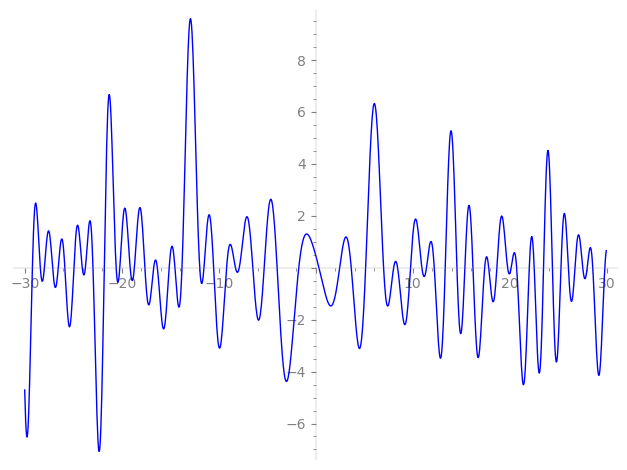| L(s) = 1 | + (−1.58 + 1.22i)2-s + 0.354·3-s + (0.993 − 3.87i)4-s + (−4.79 − 1.41i)5-s + (−0.559 + 0.434i)6-s + 6.53·7-s + (3.17 + 7.34i)8-s − 8.87·9-s + (9.31 − 3.64i)10-s − 3.31i·11-s + (0.351 − 1.37i)12-s + 17.8i·13-s + (−10.3 + 8.01i)14-s + (−1.69 − 0.501i)15-s + (−14.0 − 7.70i)16-s + 10.2i·17-s + ⋯ |
| L(s) = 1 | + (−0.790 + 0.612i)2-s + 0.118·3-s + (0.248 − 0.968i)4-s + (−0.959 − 0.283i)5-s + (−0.0932 + 0.0723i)6-s + 0.933·7-s + (0.397 + 0.917i)8-s − 0.986·9-s + (0.931 − 0.364i)10-s − 0.301i·11-s + (0.0293 − 0.114i)12-s + 1.37i·13-s + (−0.737 + 0.572i)14-s + (−0.113 − 0.0334i)15-s + (−0.876 − 0.481i)16-s + 0.603i·17-s + ⋯ |
\[\begin{aligned}\Lambda(s)=\mathstrut & 220 ^{s/2} \, \Gamma_{\C}(s) \, L(s)\cr =\mathstrut & (-0.858 - 0.512i)\, \overline{\Lambda}(3-s) \end{aligned}\]
\[\begin{aligned}\Lambda(s)=\mathstrut & 220 ^{s/2} \, \Gamma_{\C}(s+1) \, L(s)\cr =\mathstrut & (-0.858 - 0.512i)\, \overline{\Lambda}(1-s) \end{aligned}\]
Particular Values
| \(L(\frac{3}{2})\) |
\(\approx\) |
\(0.127394 + 0.461782i\) |
| \(L(\frac12)\) |
\(\approx\) |
\(0.127394 + 0.461782i\) |
| \(L(2)\) |
|
not available |
| \(L(1)\) |
|
not available |
\(L(s) = \displaystyle \prod_{p} F_p(p^{-s})^{-1} \)
| $p$ | $F_p(T)$ |
|---|
| bad | 2 | \( 1 + (1.58 - 1.22i)T \) |
| 5 | \( 1 + (4.79 + 1.41i)T \) |
| 11 | \( 1 + 3.31iT \) |
| good | 3 | \( 1 - 0.354T + 9T^{2} \) |
| 7 | \( 1 - 6.53T + 49T^{2} \) |
| 13 | \( 1 - 17.8iT - 169T^{2} \) |
| 17 | \( 1 - 10.2iT - 289T^{2} \) |
| 19 | \( 1 - 24.2iT - 361T^{2} \) |
| 23 | \( 1 + 30.4T + 529T^{2} \) |
| 29 | \( 1 + 22.6T + 841T^{2} \) |
| 31 | \( 1 - 1.17iT - 961T^{2} \) |
| 37 | \( 1 - 20.5iT - 1.36e3T^{2} \) |
| 41 | \( 1 + 39.0T + 1.68e3T^{2} \) |
| 43 | \( 1 + 35.0T + 1.84e3T^{2} \) |
| 47 | \( 1 - 18.3T + 2.20e3T^{2} \) |
| 53 | \( 1 - 60.6iT - 2.80e3T^{2} \) |
| 59 | \( 1 - 24.8iT - 3.48e3T^{2} \) |
| 61 | \( 1 - 99.4T + 3.72e3T^{2} \) |
| 67 | \( 1 - 66.1T + 4.48e3T^{2} \) |
| 71 | \( 1 + 73.5iT - 5.04e3T^{2} \) |
| 73 | \( 1 - 11.7iT - 5.32e3T^{2} \) |
| 79 | \( 1 + 91.6iT - 6.24e3T^{2} \) |
| 83 | \( 1 - 123.T + 6.88e3T^{2} \) |
| 89 | \( 1 + 6.98T + 7.92e3T^{2} \) |
| 97 | \( 1 - 113. iT - 9.40e3T^{2} \) |
| show more | |
| show less | |
\(L(s) = \displaystyle\prod_p \ \prod_{j=1}^{2} (1 - \alpha_{j,p}\, p^{-s})^{-1}\)
Imaginary part of the first few zeros on the critical line
−11.95593890207304275966192925332, −11.51977785672259700381004287885, −10.52467703637597839168123999375, −9.190698616584318873171159602222, −8.274553074795167062422069622170, −7.88233711789454463622485359917, −6.48457921336003389636202722745, −5.31360869527490245052425308717, −3.97967809070739234544293839393, −1.74927817589075109754060422951,
0.33008845552946789775586430643, 2.46522147062100734601686023332, 3.66203548643303569604820116139, 5.14408439177696067480148256024, 6.99655637853967412536113084752, 8.032374877179293520854732692147, 8.440361326923726979838909254766, 9.768988935387557545621756403686, 10.94312450739249915924172740044, 11.41851514048576237258339050492

